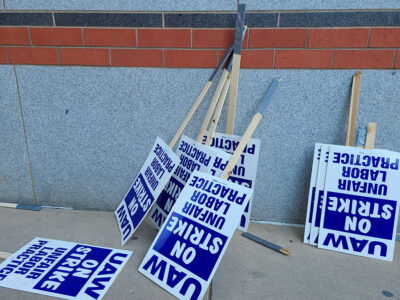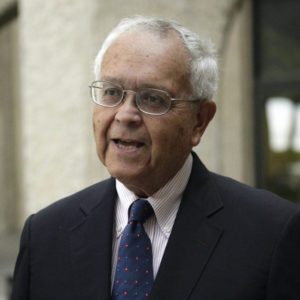William Gould on the UAW Strike and the Summer of Red-Hot Labor Unrest Extending into Fall

On Friday, September 15, members of the United Auto Workers union at the three largest U.S. automakers, General Motors, Ford Motor Company, and Chrysler-parent company Stellantis, went on strike—extending the summer of labor unrest across the U.S., when strikes by airlines and UPS were narrowly averted, but Hollywood writers and actors continue to stay out. Here, Stanford Law School’s William B. Gould IV, a labor law expert, discusses the strike and how it might be resolved.
Why did the UAW go on strike? What is the main point of contention between the union and management?
The UAW strike motivation falls into two categories. First, the UAW’s sacrifices made at the time of the Great Recession (when the UAW abandoned, among other things, its pioneering Cost of Living Adjustment, or COLA, which had protected them against inflation) to keep the companies alive has been followed by substantial profits and escalating executive compensation—all against a backdrop of growing inequality, as well as real wage decline through inflation. The second factor is the combination of technological advances and the advent of the electric car. Everyone agrees that less labor will be required to produce electric cars, so we have to ask what will become of those workers made redundant—particularly after the UAW gave up its jobs bank designed to protect laid off workers.
We’ve seen this movie before when the Midwest was decimated by the China shock and American workers were without protection like those enjoyed in Europe, particularly Scandinavia. Embittered, many workers have turned to Trump, who now tells them to fight against the electric cars. The UAW has never been an opponent of technological innovation, and, notwithstanding Trump’s entreaties, it will not oppose the electric car. And the UAW wants to represent workers in the new low-wage battery companies—companies that are contracting with the big auto companies where health and safety problems are rampant. America’s secondary boycott prohibitions make pressure on this issue against the Big Three problematic at best.

Might this strike grow?
More locations will be picked for strikes where the companies have their most profitable vehicles and perhaps where workers press for strikes.
Did the Biden administration have any power to help prevent a strike? Could it have done more to prevent it?
The Biden administration, in my view, doesn’t have the authority under the Taft-Hartley emergency strike prohibitions to stop even a full-fledged strike against all companies—economically disruptive, yes, emergency, no.
Biden could do more: He could employ the active resources of the Federal Mediation and Conciliation Service.
What would you recommend the Biden administration do to help resolve this strike?
The best thing Biden can do is to promote legislation that would expand on financial aid for worker dislocation with transition guarantees to the new battery jobs, but with this Congress I think that’s completely out of the question.
There really isn’t a second-best option because the railway dispute legislation imposing an agreement isn’t transferable and Biden wouldn’t want this. Nor is he likely to use the Taft-Hartley emergency strike injunction where he would be unsuccessful as a matter of law and, more important, he would make an enemy of the ally he needs: the labor movement.
As I said above, Biden should use the expert Federal Mediation and Conciliation Service, along with the efforts already employed by Julie Su, the acting labor secretary, and Gene Sperling, senior White House advisor, who have been leading the effort but have other things to do and aren’t as expert. They also need to induce more generous financial offers including some measure of job security compensation to the laid off through pressure against the companies. By that I mean substantial wage increases shaded toward union position, the elimination or substantial modification of a two-tier system, which has meant sharply different pay for workers doing the same job, and the restoration of COLA providing cost of living increases.
Listen to Professor William Gould on KCBS Radio Discussing the United Auto Workers Strike
Might the NLRB step in to arbitrate?
The NLRB could be involved in secondary boycott charges or if there are union allegations that companies have refused to bargain in good faith. If the Board finds either meritorious, it might seek injunctive remedies—with the boycott issue it would be mandated to do so. But the NLRB Board would be unlikely to produce an agreement.
Do you see any similarities between this strike and those in Hollywood?
Hollywood is similar because both disputes are triggered by new technology. The automakers fear declining profits with electric cars, which helps explain their resistance. Another factor is non-union competition. Here Tesla and the foreign transplants—just like UPS confronted with Amazon and Federal Express—will become more competitive.
Do you think this will last long?
The parties are far apart. I would expect the strike to build and last weeks, perhaps months.
SLS’s William Gould Discusses the ‘Hot Labor Summer’ and Why More Strikes Likely Are Coming
William B. Gould IV is a labor law expert and the Charles A. Beardsley Professor of Law, Emeritus, at Stanford Law School. A prolific scholar he is the author, most recently, of For Labor to Build Upon: Wars, Depression and Pandemic (Cambridge University Press, Spring 2022) and A Primer on American Labor Law (6th edition 2019).
